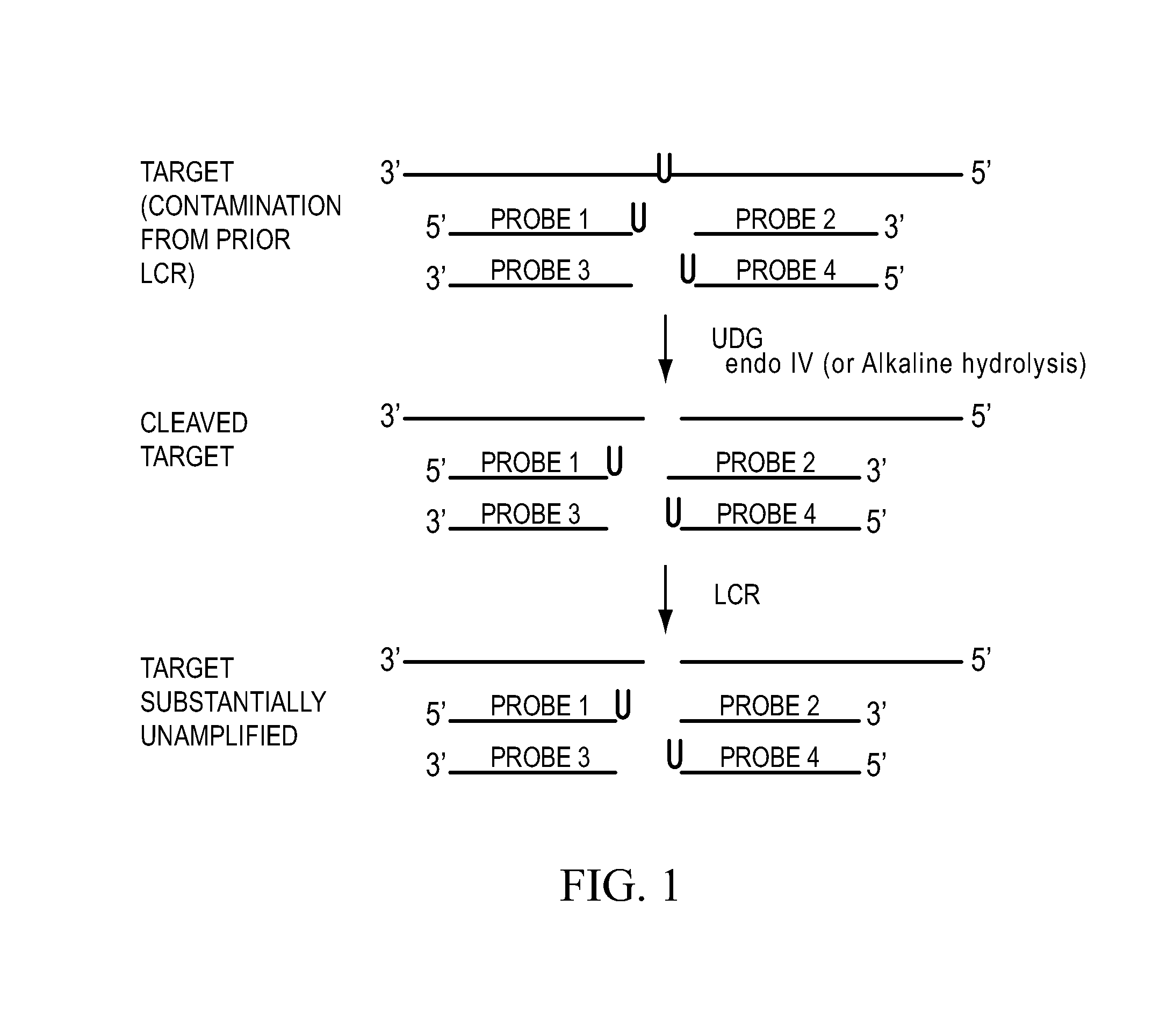Process for controlling contamination of nucleic acid amplification reactions
a technology for amplification reactions and nucleic acids, applied in biochemistry apparatus and processes, fermentation, organic chemistry, etc., can solve the problems of large amplification of the number of copies of original specific sequences, significant cost increase of pcr and lcr
- Summary
- Abstract
- Description
- Claims
- Application Information
AI Technical Summary
Benefits of technology
Problems solved by technology
Method used
Image
Examples
example 1
[0114]A polymerase chain reaction (PCR) was performed to amplify a region of the human papilloma virus type 16 (HPV 16) DNA (Durst, M. et al., Proc. Natl. Acad. Sci. USA 80:3812 (1983)). The sequences of the primers used were 5′GGTCGATGTATGTCTTGTTG3′ (SEQ ID NO:1) and 5′GTCTACGTGTGTGCTTTGTAC3′ (SEQ ID NO:2).
[0115]HPV 16 DNA was excised from a full length plasmid clone, pT7HPV16 (for the purposes of this invention, equivalent to the pUC8 plasmids described by Seedoff, K., et al., Virol. 145:181 (1985)) with the restriction enzyme BamH I. The linear DNA (10 picograms) was added to PCR reactions containing 50 microliters of 25 mM Tris HCl pH 8.3, 5 mM MgCl2, 50 mM NaCl, 0.01% gelatin, 0.05% W1 polyoxyethylene ether detergent (Sigma), 0.2 mM each dATP, dGTP, dCTP, 0.2 mM either dUTP or dTTP, 1 micromolar of each primer, and 2.5 units of thermostable DNA polymerase from Thermus aquaticus (Cetus / Perkin-Elmer). The reactions were amplified in a thermal cycler (Cetus / Perkin-Elmer) using the...
example 2
General Experimental Conditions of the Second Embodiment
[0119]Polymerase chain reactions (PCRs) were performed to amplify a region of the human papilloma virus type 16 (HPV 16) DNA (Durst, M. et al. Proc. Natl. Acad. Sci. USA 80:3812 (1983)). The sequences of the oligonucleotide primers used were either 5′GGUCGAUGUA-UGUCUUGUUG3′ (SEQ ID NO:3) and 5′GUCUACGUGUGUGCUUUGUAC3′ (SEQ ID NO:4) (dU primers dU1 and dU2, respectively) or 5′GGTCGATGTATGTCTTGTTG3′ (SEQ ID NO:5) and 5′GTCTACGTGTGTGCTTTGTAC3′ (SEQ ID NO:6) (control dT primers dT1 and dT2, respectively). Note that the sequences of dT1 and dU1 were identical except for the replacement of U for T; dT2 and dU2 were similarly identical.
[0120]HPV 16 DNA was excised from a full length plasmid clone, pT7HPV16 (for the purposes of this invention, equivalent to the pUC8-based plasmids described by Seedoff, K. et al. Virol. 145:181 (1985)) with the restriction enzyme BamH I. The linear DNA (10 picograms) was added to PCR reactions containing...
example 3
Amplification Using Two Deoxyuridine-Containing Primers
[0121]New pUxT PCR reactions were prepared that contained dTTP but lacked dU primers. These were contaminated with ten femtograms of pUxT amplification products from the previous reactions, and incubated for 15 minutes at 37° C. in the presence or absence of UDG (H. Van de Sande, University of Calgary; also available from Life Technologies Inc., P.O. Box 9418, Gaithersburg, Md. 20898). These reactions were then incubated at 94° C. to inactivate the UDG, cooled to 15° C., and dU primers were added.
[0122]New pTxU PCR reactions were prepared with dT primers and dUTP and were contaminated with ten femtograms of pTxU amplification products. These reactions were incubated at 37° C. for 15 minutes in the presence or absence of UDG to act as controls for UDG activity and PCR amplification, respectively.
[0123]The new PCR reactions were then subjected to the same PCR temperature cycling described above. Agarose / ethidium bromide gel electr...
PUM
| Property | Measurement | Unit |
|---|---|---|
| temperature | aaaaa | aaaaa |
| temperature | aaaaa | aaaaa |
| pH | aaaaa | aaaaa |
Abstract
Description
Claims
Application Information
 Login to View More
Login to View More - R&D
- Intellectual Property
- Life Sciences
- Materials
- Tech Scout
- Unparalleled Data Quality
- Higher Quality Content
- 60% Fewer Hallucinations
Browse by: Latest US Patents, China's latest patents, Technical Efficacy Thesaurus, Application Domain, Technology Topic, Popular Technical Reports.
© 2025 PatSnap. All rights reserved.Legal|Privacy policy|Modern Slavery Act Transparency Statement|Sitemap|About US| Contact US: help@patsnap.com

